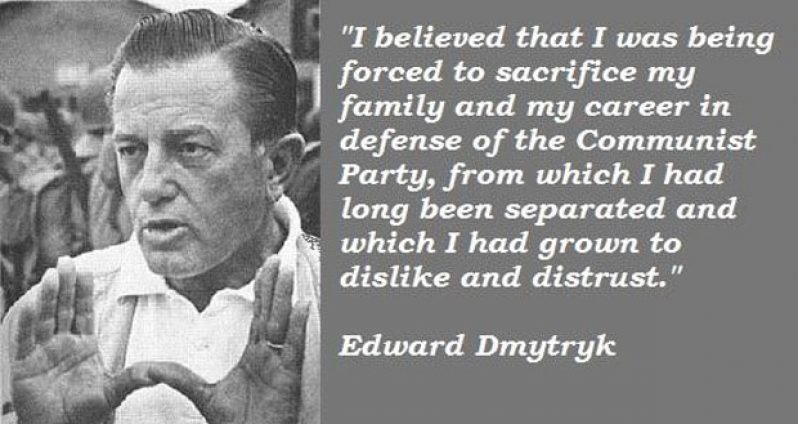IT would be unfair to claim a just review of ‘Walk on the Wild Side’ without speaking of its director, Edward Dmytryk’s artistic life, and even this film’s social relevance far beyond its North American location, mainly in the tropical Southern city of New Orleans.
DMYTRYK’S BACKGROUND
Dmytryk, like numerous other film-makers and Hollywood stars to date, was a Canadian (of Ukrainian immigrant ancestry) who only achieved artistic and professional success by crossing into the neighbouring USA during the 1930s, when he entered the Hollywood film industry as a studio assistant to ‘B’ films, until given his first opportunity in 1943 to direct an ‘A’ list film titled: ‘Tender Comrade’.
A film which, among others, ironically, would cause Dmytryk much distress and social instability half a dozen years later, when he was summoned and accused by the HUAC, ‘House of Un-American Activities’, of having Communist affiliations, and a sympathizer.

By now this embarrassing era in Hollywood film history is a stale cliché, at least for those who pay close attention to the socially effective implications of cinematic art.
But as regards the actual value and relevance of these suspected films like ‘Tender Comrade’ – including ‘Walk on the Wild Side’ of 1962 – to the social, racial, and moral problems of both North American and foreign societies, especially Guyanese society of today, these films are far from stale clichés, and remain on many levels, socially and morally relevant works of outstanding cinematic merit.
AMERICA’S SOCIAL ERA
A brief look at Dmytryk’s life brings into focus the unique creative opportunity which the past Hollywood/American film industry allowed talented foreigners to develop both personally and socially for an international audience; at least those democratically allowed to be exposed to such films.
At the same time it is realistic to assert the open-minded, even experimental, and moral influence of Franklin D. Roosevelt’s government in its ten years of extraordinary duration between the 1930s and 40s, when artists in all categories were encouraged to produce critical works of art, which coincided with a unique socialistic era in the history of the USA.
Dmytryk’s ‘Tender Comrade’ reflected the communal lifestyle and factory worker camaraderie pervasive among American women (and some men) left at home to continue in tight economic circumstances produced by the lack of prior paychecks from men now enlisted, fighting, and often dying overseas during the 2nd World War.
SOCIALISTIC HOLLYWOOD FILMS
Numerous Hollywood socialistic film classics of the 1940s Roosevelt era included: ‘The Best Years of Our Lives’; ‘Since You Went Away’; ‘The More the Merrier’; ‘They Drive By Night’; ‘Till the End of Time’; ‘Pinky’; ‘His Girl Friday’; ‘Pride of the Marines’; ‘Take a Letter Darling’, etc. They existed in conjunction with a multitude of black and white film classics in the unique American ‘Film Noir’ film form; one of the greatest cinematic styles which explored and exposed the psychological, social, economic, and even political motivations and influences behind individual and organised crime, increasingly relevant today beyond the USA.
DMYTRYK’S HOLLYWOOD PEERS
Dmytryk was just one in that long list of impressive Hollywood directors, which included: Elia Kazan, John Huston, Robert Rosen, Abraham Polonsky, Martin Ritt, Michael Curtiz, Frank Capra, Jean Negulesco, Billy Wilder, Howard Hawks, William Wyler, Delmer Daves; screen-writers like Dalton Trumbo, Robert Riskin, Lillian Hellman, Ring Lardner, William Faulkner, Raymond Chandler; actresses/actors like Lauren Bacall, Ginger Rogers, Rosalind Russell, Barbara Stanwyck, Ida Lupino, Kathy Jurado, Jennifer Jones, Bette Davis, Katherine Hepburn, Joan Crawford, Claudette Colbert, Humphrey Bogart, Henry Fonda, John Garfield, Charlie Chaplin, Danny Kaye, Fred MacMurray, Clark Gable, Dana Andrews, Spencer Tracy, Robert Ryan, Sterling Hayden, Jeff Chandler, Richard Widmark, Montgomery Clift, among others, who were homegrown American socialist sympathisers either summoned to court, or even prevented from practicing their profession, while accused of being Communist sympathisers, after the end of the Roosevelt government and the beginning of the Cold War.
One way to beat the rap was to go into exile, and Dmytryk fled to England, but served six months in prison upon his return to the USA in 1951, released only when (like others) he identified other socialists in Hollywood. A major recent honest Hollywood film concerning this era, is ‘Guilty By Suspicion’ starring Robert De Niro and Annette Bening.
DMYTRYK BEFORE ‘WALK….’
By the time Dmytryk made ‘Walk on the Wild Side’ in 1962, he had completed an unforgettable list of profound films which exposed racial bigotry, social intolerance, authoritarianism, and organized crime. Before his exile and imprisonment he made the highly rated film classics: ‘Murder My Sweet’ (1944); ‘Cornered’ (1944); ‘Crossfire’ (1947); upon his release, he made three brilliant color Westerns centered around racial bigotry, lawlessness, and organized crime: ‘Broken Lance’ (1954); ‘Raintree County’ (1957); and ‘Warlock’ (1959). But it was ‘Walk on the Wild Side’ which gave Dmytryk the chance to create a film from Nelson Algren’s novel of the same name, in which theme song, opening graphics, story or content, and cinematography, combined in perfected semiotic aesthetics.
by Terence Roberts



.png)









